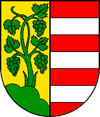Modra
| Modra | ||
|---|---|---|
| coat of arms | map | |

|
|
|
| Basic data | ||
| State : | Slovakia | |
| Kraj : | Bratislavský kraj | |
| Okres : | Pezinok | |
| Region : | Bratislava | |
| Area : | 49.624 km² | |
| Residents : | 9,046 (Dec 31, 2019) | |
| Population density : | 182 inhabitants per km² | |
| Height : | 175 m nm | |
| Postal code : | 900 01 | |
| Telephone code : | 0 33 | |
| Geographic location : | 48 ° 20 ' N , 17 ° 18' E | |
| License plate : | PK | |
| Kód obce : | 508101 | |
| structure | ||
| Community type : | city | |
| Urban area structure: | 3 districts | |
| Administration (as of November 2018) | ||
| Mayor : | Juraj Petrakovič | |
| Address: | Mestský úrad Modra Dukelská 38 90001 Modra |
|
| Website: | www.modra.sk | |
| Statistics information on statistics.sk | ||
Modra (German Modern , Hungarian Modor , Latin Modorinum ) is a city in Slovakia .
The city of Modra extends between productive vineyards at the eastern foot of the Little Carpathians , it is also called the "Pearl of the Little Carpathians". Modra is the city with the largest wine-growing area in Slovakia and is one of the centers of the Small Carpathian wine-growing region .
It is an important starting point for hikes in the Little Carpathians. The settlements Harmónia and Piesok (Zochova chata) and others, all officially districts of Modra, are popular places of rest for the residents of the Slovak capital Bratislava . They accommodate hotels and hut colonies, and many Bratislava residents have their weekend houses here. Modra is also known for the blue and white Modra ceramics (majolica) originating from the city .
structure
In addition to the main town, Modra includes two parts of the municipality ("miestna časť") Harmónia and Piesok (German sand ) and the other subdivisions Kráľová (German Königsdorf , incorporated in 1863) and Zochova chata .
history
Slavic settlements were found from the time of Great Moravia . The place Modra was mentioned in writing for the first time in 1158 in a document of the Hungarian King Géza II . After it was devastated by the Mongol invasion in 1241, the settlement was rebuilt by Hungarians and some German settlers. Modra received city rights in 1361 and it was not until 1607 that it became a free royal city . The free town has been one of the most important commercial centers in Slovakia since the 17th century and is one of the most famous wine-growing regions.
Ceramic industry and majolica factories have existed here since the beginning of the 19th century. In 1883 a Protestant pastor suggested the establishment of a technical school for ceramics, which developed the so-called Slovak ceramics based on the skills of the Habans .
The city traditionally had clashes with neighboring Pezinok . In addition, the city has become “famous” because the Bratislava – Žilina railway line bypasses it, as the city council refused to allow the construction of the railway.
Attractions
- Observatory of the Comenius University in Bratislava in the district of Zochova chata with what is currently the most modern telescope in Slovakia.
- Burial place with monument, house, museum and statue of Ľudovít Štúr ; the museum is located in the former town hall building, the monument is also dedicated to Štúr's brother, a well-known geologist
- Remains of the city fortifications built between 1610 and 1648; a bastion (with the Ignác Bizmayer Gallery) and the Upper Gate have also been preserved; the upper gate bears the inscription: "Where the Lord does not guard the city, the guards keep watch in vain"
- Country castle behind the upper gate of the city fortifications, houses the viticulture school
- a Renaissance building from the end of the 17th century on Dolná Street
- today's production workshop for Modra ceramics
- Churches:
- Roman Catholic Church of the Holy King Stefan from 1873–1876 on the market square
- Roman Catholic Church of Saint John the Baptist from the second half of the 14th century in the cemetery with a table of the names of victims of the First World War
- Evangelical Church of the Augsburg Confession (so-called "German Church"), completed in 1714, today's shape in 1834
- Protestant Church of the Holy Apostles Peter and Paul (so-called "Slovak Church"), built in 1715, today's shape in 1826, is right next to the German Church
- small baroque chapel of the Virgin Mary from 1740, stands in front of the Protestant churches
- Chapel of St. Michael from 1873
- See also: List of listed objects in Modra
Personalities
- Ignác Bizmayer , Slovak artist
- Viera Kraicová , Slovak artist
- Franz Raffelsperger (1793–1861), geographer, cartographer and civil servant
- Michael Ritthaler (1641–1685), German Lutheran theologian, school principal and librarian
- Georg Friedrich Schnaderbach (1669–1716), Protestant Lutheran preacher
- Vincent Šikula (1936–2001), Slovak writer
- Ľudovít Štúr (1815–1856), Slovak philologist and writer

